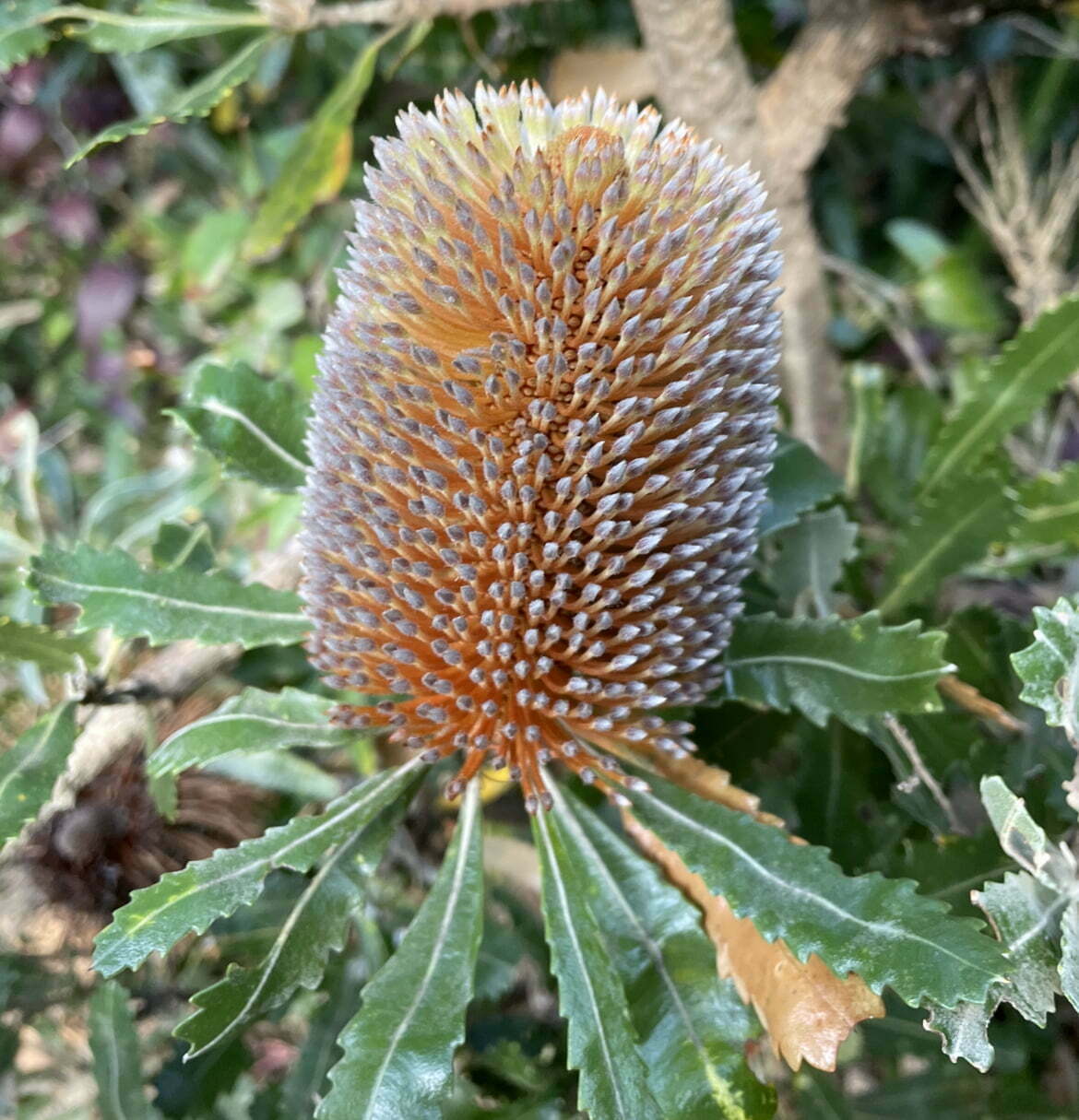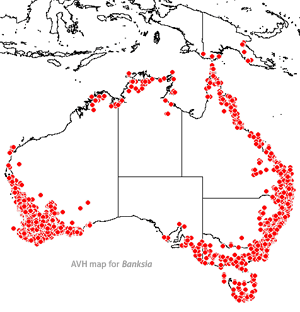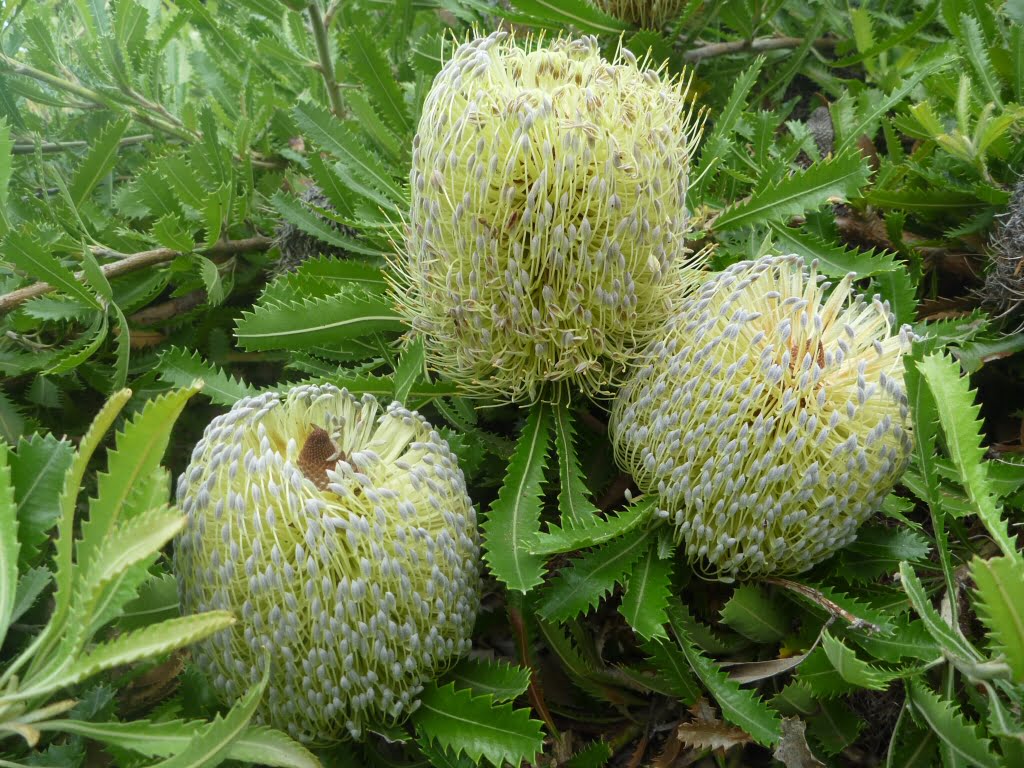
Banksia Serrata
Common name: Old Man Banksia
I grow best: Part shade/full sun
• Height up to 15m
• Sandy soil
• Flowers – Jan – June
• Attracts – Bees, birds, butterflies, other insects
• Cultural uses
• Eastern Suburb Banksia Scrub
Looks like: Banksias range from low-growing shrubs to trees. The rugged bark, serrated leaves and large flowers of this banksia give it a distinctive appearance of great value in landscaping. Plants may grow from 2 to 12 m. It is adaptable to most soils, but requires good drainage, and is frost tolerant. The flower heads are greenish yellow and open from summer to winter. A low-growing cultivar B. serrata ‘Austraflora Pygmy Possum’ is available. Some species, for example Banksia ericifolia and Banksia menziesii , are known for their spectacular flower heads. The flower heads produce large volumes of nectar and attract many birds and small mammals to feed on them. Banksias are excellent plants to encourage native animals to the garden. The Banksia Serrata is a spreading tree or shrub with gnarled appearance to 10m tall. (Dwarfed on coastal heaths). Leaves are toothed 16 x 4cm with spikes. Flowers greyish to yellow cream, with a straight cylindrical stigmas stems .The flower heads are made up of hundreds (sometimes thousands) of tiny individual flowers grouped together in pairs. The colour of the flower heads usually ranges from yellow to red. Many species flower over autumn and winter. The fruits of banksias (called follicles) are hard and woody and are often grouped together to resemble cones (which they are not true cones are produced only by conifers). The fruits protect the seeds from foraging animals and from fire. In many species the fruits will not open until they have been burnt or completely dried out.
Habitat & Propagation: Open forest, coastal dunes, Blue Mountains all states around Australia
Banksias usually grow best in well drained soils in a sunny position. Most respond to light pruning, and those which form a woody rootstock (lignotuber) can be heavily pruned. Only low phosphorus fertilisers should be used. Banksias are easily propagated from seed. A common way to release seed is to place the ‘cone’ in an oven at 120°140° C for about an hour. The follicles then open and the seeds can be removed with tweezers. Two black winged seeds are usually found in each follicle, together with a structure called a separator. Insects sometimes lay their eggs in the flower buds and the larvae may eat the seed as it develops. A small hole in the woody fruit is usually a sign that this has happened and that the seed will not germinate.
Seeds should be sown in a very freely draining seed-raising mix which should not be allowed to dry out. As Banksia seedlings are prone to fungal attack, it is better to sterilise the seed-raising mix before planting. If this is not practical, very clean ingredients should be used.
Seedlings should be transplanted into small pots as soon as the first true leaves appear. A potting mix made from equal parts of river sand, loam and leaf mould (or peat moss) is generally suitable.
| Family | Proteaceae |
| Plant Type | Small tree, Large shrub |
| Width | 4 |
| Flowering Time | Spring, Summer |
| Soil Type | Sandy, Loamy, Sandy loam, Clay loam, Saline, Poor soil |
| Climate Zone | Sub-tropical, Warm temperate, Cool temperate, Mediterranean |
| Soil Moisture | Dry, Well-drained, Moist moderate drainage |
| Special Uses | Cut flower, Bonsai, Decorative fruit, Honey producing plant |
| Height | 15 |
| Flower Colour | Cream, Yellow, Brown |
| pH Level | Acid, Neutral, Alkaline |
| Plant Environment | Low maintenance garden, Flower garden, Coastal garden, Drought resistant |
| Lifespan | Perennial |
| Frost Tolerance | Tolerates light frost |
| Attracts Wildlife | Bees, Nectar eating birds, Seed eating birds, Butterflies, Other insects |
Distribution:


